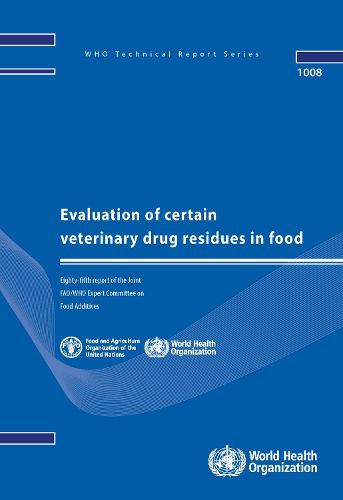Readings Newsletter
Become a Readings Member to make your shopping experience even easier.
Sign in or sign up for free!
You’re not far away from qualifying for FREE standard shipping within Australia
You’ve qualified for FREE standard shipping within Australia
The cart is loading…






This report represents the conclusions of a Joint FAO/WHO Expert Committee convened in 2017 to evaluate the safety of residues of certain veterinary drugs in food and to recommend maximum levels for such residues in food. The first part of the report considers general principles regarding the evaluation of residues of veterinary drugs within the terms of reference of the Joint FAO/WHO Expert Committee on Food Additives (JECFA), including chronic dietary exposure assessment of compounds used as veterinary drugs and pesticides, assessment of the relative bioavailability and/or pharmacological activity of incurred drug residues in animal tissues, acute reference doses (ARfDs) for residues of veterinary drugs and methodological approaches and types of data for assessment of veterinary drug residues in food. Summaries follow of the Committee’s evaluations of toxicological and residue data on a variety of veterinary drugs: three antimicrobial agents (amoxicillin, ampicillin and halquinol), an acaricide (ethion), an antiparasitic agent (flumethrin), an insecticide (lufenuron) and an anthelminthic (monepantel). In addition, the Committee considered issues raised by the Codex Committee on Residues of Veterinary Drugs in Foods concerning sisapronil, an ectoparasiticide, and zilpaterol hydrochloride, a sz2-adrenoceptor agonist. Annexed to the report is a summary of the Committee?s recommendations on these drugs, including acceptable daily intakes (ADIs), ARfDs and proposed maximum residue limits (MRLs).
$9.00 standard shipping within Australia
FREE standard shipping within Australia for orders over $100.00
Express & International shipping calculated at checkout
This report represents the conclusions of a Joint FAO/WHO Expert Committee convened in 2017 to evaluate the safety of residues of certain veterinary drugs in food and to recommend maximum levels for such residues in food. The first part of the report considers general principles regarding the evaluation of residues of veterinary drugs within the terms of reference of the Joint FAO/WHO Expert Committee on Food Additives (JECFA), including chronic dietary exposure assessment of compounds used as veterinary drugs and pesticides, assessment of the relative bioavailability and/or pharmacological activity of incurred drug residues in animal tissues, acute reference doses (ARfDs) for residues of veterinary drugs and methodological approaches and types of data for assessment of veterinary drug residues in food. Summaries follow of the Committee’s evaluations of toxicological and residue data on a variety of veterinary drugs: three antimicrobial agents (amoxicillin, ampicillin and halquinol), an acaricide (ethion), an antiparasitic agent (flumethrin), an insecticide (lufenuron) and an anthelminthic (monepantel). In addition, the Committee considered issues raised by the Codex Committee on Residues of Veterinary Drugs in Foods concerning sisapronil, an ectoparasiticide, and zilpaterol hydrochloride, a sz2-adrenoceptor agonist. Annexed to the report is a summary of the Committee?s recommendations on these drugs, including acceptable daily intakes (ADIs), ARfDs and proposed maximum residue limits (MRLs).